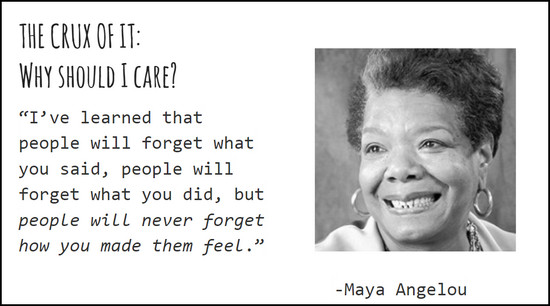Better storytelling leads to better planning
By Sharlan Douglas, APR
- “Why don’t they get it?”
- “Why can’t we get that underrepresented group of citizens* to participate?”
- “Well if only 10 people came to our town hall, then that’s what we’re going to go with.”
- “Since we lost the local paper people don’t know what we’re doing.”
*Parents, young people, low-income residents, ethnic/religious communitiesRecognizing those common themes, the Michigan Association of Planning asked Metromode editor Nina Ignaczak, AICP and me to present “Storytelling for Planners” at its October, 2016 conference. Our essential assumption was that planners don’t want just any plan. They want plans that truly represent the views of the people in their communities.Here are highlights from our presentation.
Simplify, simplify, simplify!
I say this with love: Planners are nerds. We love statistics, spreadsheets and charts. We speak in jargon. That doesn’t work for our general audiences. We give them this: When they need this:
When they need this:
Humans are “wired for story.”
Stories are how we survive. Here’s a useful TED talk on the topic. Don’t have 17 minutes? Watch from 8:07 to 10:45.
People will care about your plans when you make your stories their stories.
Think like a reporter.
Look for stories. It’s not too hard. They’re all around you. People phone you with questions, criticism or praise. They come to public meetings, attend your events, post on social media. They WANT to tell their stories. All you have to do is listen and record what they say. Be interested not interesting. Ask open-ended questions. Let silences linger; people will fill them. Be dumb. Say, “Tell me more about that.”
Go where the stories are.
It’s not enough to say “We held a town hall and nobody came.” Set up a kiosk at the library or senior center or a booth at the farmer’s market. Get permission to go to a church that isn’t your own – especially if it’s a temple, mosque or synagogue – to talk with people after coffee hour or in a special meeting. Meet with the PTA. Go to kids soccer games.
You own the channels. Use them.
The loss of traditional media, like local papers, has been offset by abundant channels THAT YOU CONTROL. Start with your community’s website and Facebook page then move on to Instagram and Youtube. Snapchat and Twitter have a little bigger learning curve.
Any story is better than no story.
A captioned photo would be enough but you’ve got a media studio right in your pocket, with photos and audio and video recordings at your fingertips. You’d be amazed at what you can edit and produce right on your smartphone. With Adobe Spark on your computer, you can create presentations superior to Powerpoint in the same or even less time.Nina created this excellent list of links to digital storytelling tools. Poke around there. Then get started telling your stories. You don’t have to be complete or perfect. Just do something.

